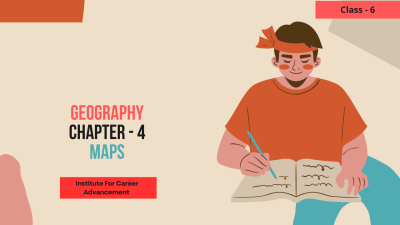Course description
This unit on Maps introduces students to the concept of maps, their significance, and the various types of maps used to represent different features of the Earth’s surface. Students will learn the basics of map reading, understanding symbols, and using directions. This unit also covers key geographical tools such as scales, legends, and grids, which are essential for interpreting maps accurately.
Key Topics Covered:
Introduction to Maps:
Understanding what maps are and their importance in representing the Earth’s surface.
The difference between maps and globes and when each is used.
Advantages of using maps for various purposes, such as navigation, studying geography, and planning.
Types of Maps:
Physical Maps: Show natural features like mountains, rivers, and plains.
Political Maps: Display boundaries of countries, states, and important cities.
Thematic Maps: Represent specific information like climate, population, or rainfall in a particular area.
Topographical Maps: Show the elevation and contour of land using contour lines.
How each type of map serves a different purpose.
Components of a Map:
Title: Gives an idea of what the map is about.
Direction: Use of the compass rose (North, South, East, West) to show directions on a map.
Scale: Understanding the map scale to interpret distances correctly. Explanation of how a scale helps in converting map distances to real-life distances.
Legend/Key: Understanding the symbols, colors, and icons used to represent different features on a map.
Grid System: Introduction to the use of grids (latitude and longitude) for locating places on a map.
Understanding Directions:
Learning how to use cardinal directions (North, South, East, West) and intermediate directions (Northeast, Northwest, Southeast, Southwest).
Understanding the importance of direction in map reading and navigation.
Map Symbols and Their Meanings:
Learning common symbols used on maps, such as rivers, roads, mountains, airports, and railway lines.
Understanding how to interpret these symbols using the map’s legend or key.
Understanding the Scale of Maps:
Introduction to the concept of scale, explaining the ratio of distance on a map to the actual distance on the ground.
Examples of small-scale maps (showing large areas with less detail) vs. large-scale maps (showing smaller areas with more detail).
Using Grids for Location:
Understanding how grids (using latitude and longitude or alphanumeric grids) help in identifying the exact location of places on a map.
Practical Applications of Maps:
Learning how maps are used in everyday life for traveling, urban planning, weather forecasting, and disaster management.
Introduction to modern tools like Google Maps and GPS technology.
মানচিত্রের এই ইউনিটটি শিক্ষার্থীদের মানচিত্রের ধারণা, তাদের তাৎপর্য এবং পৃথিবীর পৃষ্ঠের বিভিন্ন বৈশিষ্ট্যের প্রতিনিধিত্ব করতে ব্যবহৃত বিভিন্ন ধরনের মানচিত্রের সাথে পরিচয় করিয়ে দেয়। শিক্ষার্থীরা মানচিত্র পড়া, প্রতীক বোঝা এবং নির্দেশাবলী ব্যবহার করার মৌলিক বিষয়গুলি শিখবে। এই ইউনিটটি স্কেল, কিংবদন্তি এবং গ্রিডের মতো মূল ভৌগলিক সরঞ্জামগুলিকেও অন্তর্ভুক্ত করে, যা মানচিত্রের সঠিক ব্যাখ্যার জন্য প্রয়োজনীয়।
মূল বিষয়গুলিঃ মানচিত্রের পরিচিতিঃ
মানচিত্রগুলি কী এবং পৃথিবীর পৃষ্ঠকে প্রতিনিধিত্ব করার ক্ষেত্রে তাদের গুরুত্ব কী তা বোঝা।
মানচিত্র এবং গোলকগুলির মধ্যে পার্থক্য এবং যখন প্রতিটি ব্যবহার করা হয়।
নেভিগেশন, ভূগোল অধ্যয়ন এবং পরিকল্পনার মতো বিভিন্ন উদ্দেশ্যে মানচিত্র ব্যবহারের সুবিধা।
মানচিত্রের প্রকারঃ
ভৌত মানচিত্রঃ পাহাড়, নদী এবং সমভূমির মতো প্রাকৃতিক বৈশিষ্ট্যগুলি দেখান।
রাজনৈতিক মানচিত্রঃ দেশ, রাজ্য এবং গুরুত্বপূর্ণ শহরগুলির সীমানা প্রদর্শন করুন।
থিম্যাটিক মানচিত্রঃ একটি নির্দিষ্ট অঞ্চলে জলবায়ু, জনসংখ্যা বা বৃষ্টিপাতের মতো নির্দিষ্ট তথ্য উপস্থাপন করে।
ভূসংস্থানিক মানচিত্রঃ কনট্যুর লাইন ব্যবহার করে জমির উচ্চতা এবং কনট্যুর দেখান।
কিভাবে প্রতিটি ধরনের মানচিত্র একটি ভিন্ন উদ্দেশ্যে কাজ করে।
একটি মানচিত্রের উপাদানঃ
শিরোনামঃ মানচিত্রটি কী সম্পর্কে একটি ধারণা দেয়।
দিকনির্দেশঃ একটি মানচিত্রে দিকনির্দেশ দেখানোর জন্য কম্পাসের গোলাপ (উত্তর, দক্ষিণ, পূর্ব, পশ্চিম) ব্যবহার করা হয়।
স্কেলঃ দূরত্ব সঠিকভাবে ব্যাখ্যা করার জন্য মানচিত্রের স্কেল বোঝা। একটি স্কেল কীভাবে মানচিত্রের দূরত্বকে বাস্তব জীবনের দূরত্বে রূপান্তরিত করতে সহায়তা করে তার ব্যাখ্যা।
কিংবদন্তি/কীঃ মানচিত্রে বিভিন্ন বৈশিষ্ট্যের প্রতিনিধিত্ব করতে ব্যবহৃত প্রতীক, রঙ এবং আইকনগুলি বোঝা।
গ্রিড ব্যবস্থাঃ মানচিত্রে স্থান নির্ধারণের জন্য গ্রিড (অক্ষাংশ এবং দ্রাঘিমাংশ) ব্যবহারের প্রবর্তন।
দিকনির্দেশগুলি বোঝাঃ
প্রধান দিকগুলি (উত্তর, দক্ষিণ, পূর্ব, পশ্চিম) এবং মধ্যবর্তী দিকগুলি কীভাবে ব্যবহার করতে হয় তা শিখুন (Northeast, Northwest, Southeast, Southwest).
মানচিত্র পড়া এবং নেভিগেশনে দিকনির্দেশনার গুরুত্ব বোঝা।
মানচিত্রের প্রতীক এবং তাদের অর্থঃ
মানচিত্রে ব্যবহৃত সাধারণ প্রতীকগুলি শেখা, যেমন নদী, রাস্তা, পাহাড়, বিমানবন্দর এবং রেলপথ।
মানচিত্রের কিংবদন্তি বা চাবি ব্যবহার করে এই প্রতীকগুলিকে কীভাবে ব্যাখ্যা করা যায় তা বোঝা।
মানচিত্রের মাপকাঠি বোঝাঃ
স্কেলের ধারণার ভূমিকা, একটি মানচিত্রে দূরত্বের অনুপাত এবং স্থলভাগের প্রকৃত দূরত্ব ব্যাখ্যা করে।
ছোট মাপের মানচিত্রের উদাহরণ (কম বিশদ সহ বড় এলাকা দেখাচ্ছে) বনাম বড় মাপের মানচিত্র (showing smaller areas with more detail).
অবস্থানের জন্য গ্রিড ব্যবহার করাঃ
গ্রিডগুলি (অক্ষাংশ এবং দ্রাঘিমাংশ বা বর্ণানুক্রমিক গ্রিড ব্যবহার করে) কীভাবে মানচিত্রে স্থানগুলির সঠিক অবস্থান সনাক্ত করতে সহায়তা করে তা বোঝা।
মানচিত্রের ব্যবহারিক প্রয়োগঃ
ভ্রমণ, নগর পরিকল্পনা, আবহাওয়ার পূর্বাভাস এবং দুর্যোগ ব্যবস্থাপনার জন্য দৈনন্দিন জীবনে মানচিত্র কীভাবে ব্যবহার করা হয় তা শিখুন।
গুগল ম্যাপ এবং জিপিএস প্রযুক্তির মতো আধুনিক সরঞ্জামগুলির পরিচিতি।



















